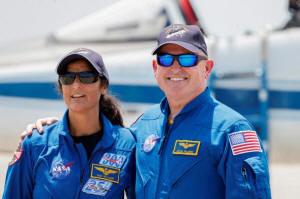Boeing's Starliner astronauts could return on SpaceX capsule in Feb
2025, NASA says
 Send a link to a friend
Send a link to a friend
 [August 08, 2024]
By Joey Roulette [August 08, 2024]
By Joey Roulette
WASHINGTON (Reuters) -NASA officials said on Wednesday the two
astronauts delivered to the International Space Station in June by
Boeing's Starliner could return on SpaceX's Crew Dragon in February 2025
if Starliner is still deemed unsafe to return to Earth.
The U.S. space agency has been discussing potential plans with SpaceX to
leave two seats empty on an upcoming Crew Dragon launch for NASA
astronauts Butch Wilmore and Suni Williams, who became the first crew to
fly Boeing's Starliner capsule.
The astronauts' test mission, initially expected to last about eight
days on the station, has been drawn out by issues on Starliner's
propulsion system that have increasingly called into question the
spacecraft's ability to safely return them to Earth as planned.
A Boeing spokesperson said if NASA decides to change Starliner's
mission, the company "will take the actions necessary to configure
Starliner for an uncrewed return."
Thruster failures during Starliner's initial approach to the ISS in June
and several leaks of helium - used to pressurize those thrusters - have
set Boeing off on a testing campaign to understand the cause and propose
fixes to NASA, which has the final say. Recent results have unearthed
new information, causing greater alarm about a safe return.
The latest test data have stirred disagreements and debate within NASA
about whether to accept the risk of a Starliner return to Earth, or make
the call to use Crew Dragon instead.

Using a SpaceX craft to return astronauts that Boeing had planned to
bring back on Starliner would be a major blow to an aerospace giant that
has struggled for years to compete with SpaceX and its more experienced
Crew Dragon.
Starliner has been docked to the ISS for 63 of the maximum 90 days it
can stay, and it is parked at the same port that Crew Dragon will have
to use to deliver the upcoming astronaut crew.
Early Tuesday morning, NASA, using a SpaceX rocket and a Northrop
Grumman capsule, delivered a routine shipment of food and supplies to
the station, including extra clothes for Wilmore and Williams.
Starliner's high-stakes mission is a final test required before NASA can
certify the spacecraft for routine astronaut flights to and from the ISS.
Crew Dragon received NASA approval for astronaut flights in 2020.
Starliner development has been set back by management issues and
numerous engineering problems. It has cost Boeing $1.6 billion since
2016, including $125 million from Starliner's current test mission,
securities filings show.
[to top of second column]
|

NASA astronauts Butch Wilmore and Suni Williams pose ahead of the
launch of Boeing's Starliner-1 Crew Flight Test (CFT), in Cape
Canaveral, Florida, U.S., April 25, 2024. REUTERS/Joe Skipper/File
Photo

CONCERNS AT NASA
A meeting this week of NASA's Commercial Crew Program, which
oversees Starliner, ended with some officials disagreeing with a
plan to accept Boeing's testing data and use Starliner to bring the
astronauts home, officials said during a news conference.
"We didn't poll in a way that led to a conclusion," Commercial Crew
Program chief Steve Stich said.
"We heard from a lot of folks that had concerns, and the decision
was not clear," Ken Bowersox, NASA's space operations chief, added.
A Boeing executive was not at the Wednesday press conference.
While no decision has been made on using Starliner or Crew Dragon,
NASA has been buying Boeing more time to do more testing and gather
more data to build a better case to trust Starliner. Sometime next
week is when NASA expects to decide, officials said.
The agency on Tuesday delayed by more than a month SpaceX's upcoming
Crew Dragon mission, a routine flight called Crew-9, that is
expected to send three NASA astronauts and a Russian cosmonaut to
the ISS.
NASA's ISS program chief said the agency has not yet decided which
astronauts they would pull off the mission for Wilmore and Williams
if needed.
Boeing's testing so far has shown that four of Starliner's jets had
failed in June because they overheated and automatically turned off,
while other thrusters re-fired during tests appeared weaker than
normal because of some restriction to their propellant.
Ground tests in late July at the White Sands Missile Range in New
Mexico have helped reveal that the thrusters' overheating causes a
teflon seal to warp, choking propellant tubes for the thrusters and
thereby weakening their thrust.
"That, I would say, upped the level of discomfort, and not having a
total understanding of the physics of what's happening," Stich said,
describing why NASA now appears more willing to discuss a Crew
Dragon contingency after previously downplaying such a prospect to
reporters.
(Reporting by Joey Roulette; Editing by Nick Zieminski and Chris
Sanders)
[© 2024 Thomson Reuters. All rights
reserved.]This material
may not be published, broadcast, rewritten or redistributed.
Thompson Reuters is solely responsible for this content. |